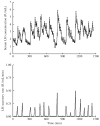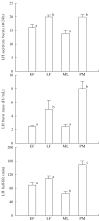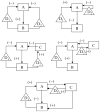Biomathematical modeling of pulsatile hormone secretion: a historical perspective
- PMID: 19216934
- PMCID: PMC2662597
- DOI: 10.1016/S0076-6879(08)03814-7
Biomathematical modeling of pulsatile hormone secretion: a historical perspective
Abstract
Shortly after the recognition of the profound physiological significance of the pulsatile nature of hormone secretion, computer-based modeling techniques were introduced for the identification and characterization of such pulses. Whereas these earlier approaches defined perturbations in hormone concentration-time series, deconvolution procedures were subsequently employed to separate such pulses into their secretion event and clearance components. Stochastic differential equation modeling was also used to define basal and pulsatile hormone secretion. To assess the regulation of individual components within a hormone network, a method that quantitated approximate entropy within hormone concentration-times series was described. To define relationships within coupled hormone systems, methods including cross-correlation and cross-approximate entropy were utilized. To address some of the inherent limitations of these methods, modeling techniques with which to appraise the strength of feedback signaling between and among hormone-secreting components of a network have been developed. Techniques such as dynamic modeling have been utilized to reconstruct dose-response interactions between hormones within coupled systems. A logical extension of these advances will require the development of mathematical methods with which to approximate endocrine networks exhibiting multiple feedback interactions and subsequently reconstruct their parameters based on experimental data for the purpose of testing regulatory hypotheses and estimating alterations in hormone release control mechanisms.
Figures









Similar articles
-
Approximate entropy studies of hormone pulsatility from plasma concentration time series: influence of the kinetics assessed by simulation.Ann Biomed Eng. 2000 Jun;28(6):665-76. doi: 10.1114/1.1306344. Ann Biomed Eng. 2000. PMID: 10983712
-
Gender and sexual maturation-dependent contrasts in the neuroregulation of growth hormone secretion in prepubertal and late adolescent males and females--a general clinical research center-based study.J Clin Endocrinol Metab. 2000 Jul;85(7):2385-94. doi: 10.1210/jcem.85.7.6697. J Clin Endocrinol Metab. 2000. PMID: 10902783 Clinical Trial.
-
Bayesian deconvolution analysis of pulsatile hormone concentration profiles.Biometrics. 2003 Sep;59(3):650-60. doi: 10.1111/1541-0420.00075. Biometrics. 2003. PMID: 14601766
-
Novel modalities for appraising individual and coordinate pulsatile hormone secretion: the paradigm of luteinizing hormone and testosterone release in the aging male.Mol Psychiatry. 1997 Jan;2(1):70-80. doi: 10.1038/sj.mp.4000232. Mol Psychiatry. 1997. PMID: 9154220 Review.
-
Motivations and methods for analyzing pulsatile hormone secretion.Endocr Rev. 2008 Dec;29(7):823-64. doi: 10.1210/er.2008-0005. Epub 2008 Oct 21. Endocr Rev. 2008. PMID: 18940916 Free PMC article. Review.
Cited by
-
Bayesian analysis improves pulse secretion characterization in reproductive hormones.Syst Biol Reprod Med. 2018 Feb;64(1):80-91. doi: 10.1080/19396368.2017.1411541. Epub 2017 Dec 29. Syst Biol Reprod Med. 2018. PMID: 29287490 Free PMC article.
-
Diabetes: Models, Signals, and Control.IEEE Rev Biomed Eng. 2009 Jan 1;2:54-96. doi: 10.1109/RBME.2009.2036073. IEEE Rev Biomed Eng. 2009. PMID: 20936056 Free PMC article.
References
-
- Atkinson LE, Bhattacharya AN, Monroe SE, Dierschke DJ, Knobil E. Effects of gonadectomy on plasma LH concentration in the rhesus monkey. Endocrinology. 1970;87:847–849. - PubMed
-
- Backstrom CT, McNeilly AS, Leask RM, Baird DT. Pulsatile secretion of LH, FSH, prolactin, oestradiol and progesterone during the human menstrual cycle. Clin Endocrinol. 1982;17:29–42. - PubMed
-
- Bergman RN, Ider YZ, Bowden CR, Cobelli C. Quantitative estimation of insulin sensitivity. Am J Physiol. 1979;236:E667–E677. - PubMed
-
- Booth RA, Jr, Weltman JY, Yankov VI, Murray J, Davison TS, Rogol AD, Asplin CM, Johnson ML, Veldhuis JD, Evans WS. Mode of pulsatile follicle-stimulating hormone secretion in gonadal hormone-sufficient and -deficient women: A clinical research center study. J Clin Endocrinol Metab. 1996;81:3208–3214. - PubMed
-
- Burger CW, Korsen T, van Kessel H, van Dop PA, Caron FJ, Schoemaker J. Pulsatile luteinizing hormone patterns in the follicular phase of the menstrual cycle, polycystic ovarian disease (PCOD) and non-PCOD secondary amenorrhea. J Clin Endocrinol Metab. 1985;61:1126–1132. - PubMed
Publication types
MeSH terms
Substances
Grants and funding
LinkOut - more resources
Full Text Sources
Medical

